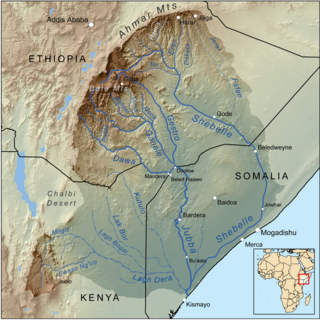
The Omo River in southern Ethiopia is the largest Ethiopian river outside the Nile Basin. Its course is entirely contained within the boundaries of Ethiopia, and it empties into Lake Turkana on the border with Kenya. The river is the principal stream of an endorheic drainage basin, the Turkana Basin.
The Germama River, is a tributary of the Awash River in Ethiopia. The name Germama comes from the Amharic word which means "frolicking", "boisterous", or "frisky".
Katar River is a river of central Ethiopia. It arises from the glaciated slopes of Mount Kaka and Mount Badda in the Arsi Zone. The Katar's tributaries include the Gonde. The gradient of the river is generally steep, and areas suitable for irrigation are few in number and very limited in extent. With a watershed of 3,398 km2, the Katar drains into Lake Ziway. It is the largest river draining into Lake Ziway.

The Mille River is a river of Ethiopia and a tributary of the Awash. It drains parts of the Semien (North) Wollo and Debub (South) Wollo Zones of the Amhara Region, as well as Administrative Zone 4 of the Afar Region. The explorer L.M. Nesbitt, who travelled through the area in 1928, was impressed by its size, and described the Mille as "probably the only real river which joins the Awash". The Ala River (A'ura) and Golima River (Golina) are small tributaries of the Mille.
The Ataye is a river in central Ethiopia. It flows into the Awash River via an unnamed stretch of river.
Borkana River is a river of central Ethiopia. A left tributary of the Awash. Johann Ludwig Krapf records that it was called "Tshaffa" by the local Oromo people.
The Dembi is a river of southwestern Ethiopia, in the Debub Bench district.

The Erer is a perennial river of eastern Ethiopia. It rises near the city of Harar, in Harari Region, and flows in a primarily southern direction to its confluence with the Shabelle.

Fafen River is a river of eastern Ethiopia. Rising to the east of Harar, in Harari Region, it cuts through a series of wide, flat shelves of sedimentary rocks made of sandstone, limestone, and gypsum as it descends in a south-eastern direction towards the Shebelle River. The Fafen only joins the Shebelle river during times of heavy rainfall.
Galetti River is a river in eastern Ethiopia. It is a tributary of the Ramis River, which is in turn a tributary of the 2,714 km long Shebelle River.
Gololcha River is a river of eastern Ethiopia. It flows into the Awash River.
The Kabenna is a river of central Ethiopia. It is a tributary of the Awash River to its west, having its source to the southwest of Ankobar. G.W.B. Huntingford speculates that it may be the same river as the Kuba, which is mentioned in the Futuh al-habaša, the narrative of Imam Ahmad Gragn's conquest of the Ethiopian Empire.
The Keleta is a river in Ethiopia. It arises near the Chilalo mountains and flows into the Awash River.
Kibish River is a river of southern Ethiopia, which defines part of that country's border with South Sudan and Kenya. It flows towards Lake Turkana, although some years it does not have enough volume to reach it, as C.W. Gwynn discovered in 1908.
Mago River is a river of southern Ethiopia, entirely located in the Debub Omo Zone of the Southern Nations, Nationalities, and People's Region. It joins the Neri River to form the Usno River, a tributary of the Omo River.
The Meki is a river in central Oromia, Ethiopia. It empties into Hora-Dambal.

Weyib River is a river of eastern Ethiopia. It rises in the Bale Mountains east of Goba in the Oromia Region, flowing east to pass through the Sof Omar Caves, then to the southeast until it joins the Ganale Dorya River in the Somali Region.

The Welmel is a river of eastern Ethiopia. It is a tributary of the Ganale Dorya River, which in turn is a tributary of the Jubba River. The headwaters of the Welmel are in the Bale Mountains of the Ethiopian Highlands, and it flow southeast for 311 km (193 mi) to its mouth.

The Shungura Formation is a stratigraphic formation located in the Omo river basin in Ethiopia. It dates to the Late Pliocene to Early Pleistocene. Oldowan tools have been found in the formation, suggesting early use of stone tools by hominins. Among many others, fossils of Panthera were found in Member G of the formation.
The Belessa River is a tributary of the Mereb River in Ethiopia. Part of its course forms a section of border between Ethiopia and Eritrea.





